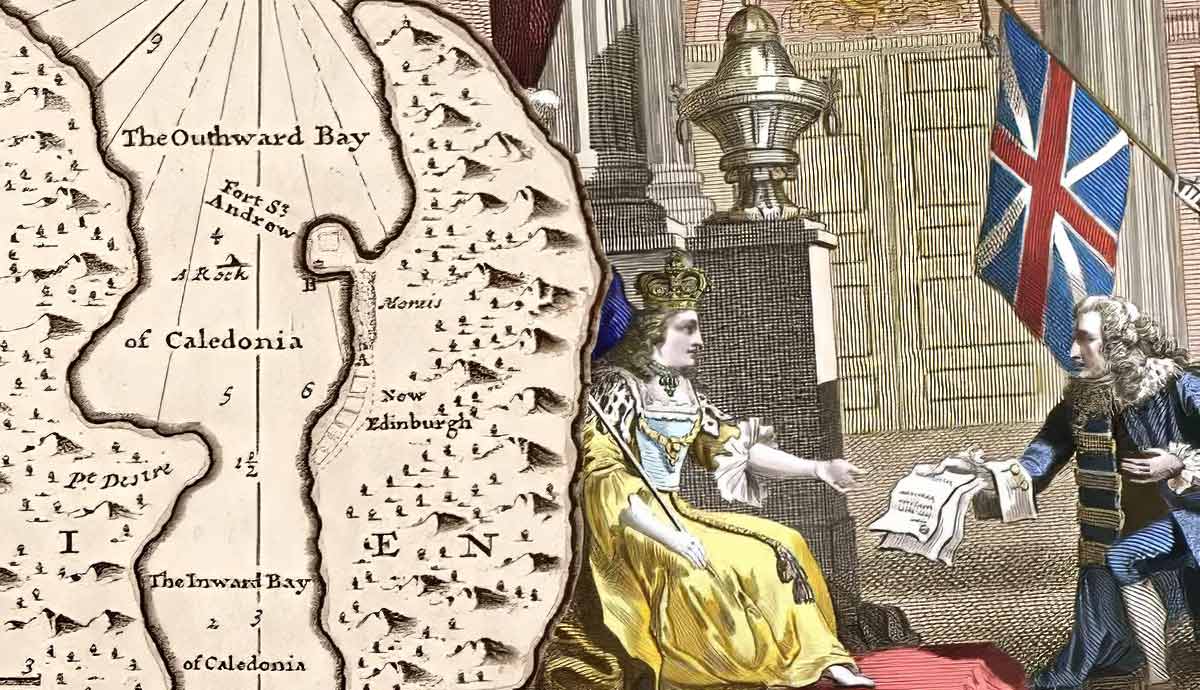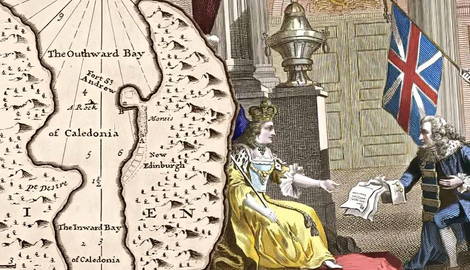
In 1698, five ships set sail from Scotland with 1,200 colonists and enough food supplies for one year. Led by the ambitious William Paterson and backed by a significant share of the nation’s available capital. The objective was to create an intermediary for European trade on the Caribbean coast of Panama. Just eight disastrous months later, fewer than three hundred of the expedition’s survivors sailed home. They returned to port mere days after the departure of a second–and equally doomed–Scottish expedition (Charles Mann, 2011).
Ultimately, the Darien scheme claimed the lives of over 2,000 Scottish colonists and likely motivated the Articles of Union between Scotland and England in 1707, resulting in the creation of Great Britain.
From Cold to Commerce: Connecting Europe’s Little Ice Age to the Darien Scheme

The late 17th century was a turbulent time for Scotland. Harsh climatic conditions and crop failures provoked by the Little Ice Age were acutely felt, especially by the Scottish poor. Between 1693 and 1700, seven out of eight oat harvests failed across all upland parishes. Known as the “Seven Ill Years,” the events of the 1690s left people grappling with hunger and instability. Depopulation affected whole tracts of the countryside, with some parishes reporting the loss of nearly two-thirds of their citizenry – a greater tragedy than even the historic Black Death (HH Lamb, 1982).
The loss of traditional trading partners further compounded these challenges. A series of brutal military conflicts among neighboring powers resulted in political upheaval and disruptions to Scotland’s trade relationship with Europe. The Nine Years War reached Scottish shores in the late 17th century thanks to extensive fighting between supporters of King William III and the recently deposed James II. Due to the ongoing violent power struggles and rivalries, uncertainty reigned across the continent while trade and economic investments declined. With communities shattered and livelihoods upended, Scotland needed an urgent solution to the dire problem of widespread suffering.
Against this background of crisis and instability, the Darien scheme emerged as an ambitious endeavor intended to reverse Scotland’s economic misfortunes. A successful colony on the American continent would allow Scottish merchants to avoid the chaos in Europe, granting them privileged access to international markets. Of course, the colonization of the Americas symbolized more than untapped resources and access to new trade routes. It was also an opportunity to reverse Scotland’s misfortunes and position the nation as a significant commercial player on the global stage.
William Paterson’s Obsession with the Isthmus of Panama

The upheaval in Scotland throughout the 1690s was undoubtedly the catalyst for the Darien expedition. However, the scheme owes its existence to the enduring fixation of Scottish merchant William Paterson. Indeed, Paterson spent the better part of a decade fruitlessly trying to convince European monarchs to fund a colony in the Darien. After successive failures, he convinced his native Scotland to take on the venture. His long-standing, grandiose vision was nothing less than to establish an “arbitrator of the commercial world” on the Isthmus of Panama.
William Paterson was born into a Scottish farming family and spent his early adulthood predominantly in the Bahamas. There, according to historian John Prebble (1968), he worked as a merchant – or, by some accounts, a buccaneer. During these years, he reportedly became obsessed with establishing a settlement in Panama to streamline European trade with civilizations in the Far East. Upon returning to Europe in the 1680s, Paterson unsuccessfully pitched the idea of a Darien colony to several European powers, including James II, the Dutch Republic, and even the Holy Roman Empire. His proposals were roundly rejected, and he moved to London in 1687 (Prebble, 1968).
Upon settling in London, Paterson joined the Merchant Taylors’ Company as a trader and accumulated significant wealth through his involvement in the slave trade (Prebble, 1968). In 1694, thanks to newly acquired wealth and power, he co-founded the prestigious Bank of England and was named its director. His tenure was short-lived, however, and he withdrew from the bank in 1695 following a rift with his colleagues. Paterson returned to his native Scotland, where he set about convincing the badly besieged Scottish government to fund his Darien scheme (Prebble, 1968).
A Plan to Open up the World: The Company of Scotland Trading to Africa & the Indies

On June 26, 1695, the Scottish Parliament passed an Act establishing the Company of Scotland Trading to Africa and the Indies, making Paterson’s vision a reality. With a proposed capital of £600,000 sterling, the Company would boost Scotland’s economy by trading Scottish-made goods worldwide. Public subscription was to fund the entire enterprise, with half raised in Scotland and half in England.
However, the project quickly lost English funding after King William and the English Parliament withdrew their support. Undeterred, more than 1,400 Scots subscribed to the Company of Scotland, successfully raising £400,000 by August 1696. By some estimates, the investment totaled as much as 40% of the country’s available capital. The Latin motto adorning the Company’s coat of arms summarized Scottish aspirations for the endeavor: “Where the world is opened up, it’s strength, being united, becomes stronger.”
The Doomed Scottish Colony of New Caledonia

In July 1698, five ships set sail from Scotland loaded with 1,200 colonists, a year’s supply of food, and the nation’s finest trading commodities – including 25,000 pairs of leather shoes (Mann, 2011). They intended to establish New Caledonia as an influential trading post, allowing Scotland to gain a commercial foothold in the Americas. After a relatively uneventful five-month journey, the colonizers landed on the Panamanian coast. According to Prebble (1968), they immediately started building the port of New Edinburgh on land belonging to the Guna near the modern-day border with Colombia.
Eight disastrous months later, fewer than 300 survivors abandoned the settlement and sailed home – Paterson among them. Mere days before their return to Scotland, a second expedition set sail for New Caledonia: four ships and 1,300 colonists. It, too, returned home nine months later with less than 100 survivors (Mann, 2011).

The Darien scheme was an unmitigated disaster from the start. Agriculture proved difficult, and hunger quickly set in after weather and improper storage measures destroyed the expedition’s food stores. Catastrophically for Scottish commercial ambitions, attempts to trade with Indigenous peoples and passing ships proved unsuccessful. Relationships in the colony were severely strained by poor management, with leaders and sailors remaining on ships and hoarding food gifted by Indigenous communities.
Meanwhile, the mortality rate reached ten settlers per day. As New Edinburgh grew desperate, King William of England further weakened the settlement’s chances by instructing his colonies not to help the Scots. Worse still, Spain knew about the scheme and periodically attacked. The primary cause of the high death toll, though, was disease. Historical records indicate dozens of deaths each week from malaria, dysentery, and yellow fever. Following Spain’s first attack on New Edinburgh, its soldiers reported finding over four hundred fresh graves – all victims of disease (Mann, 2011).
From Disaster in Panama to Union with England

The disastrous Darien scheme wiped out a significant percentage of Scotland’s capital. Letters sent home by the expedition’s leaders gave the false impression that things were going well, leaving Scottish investors wholly unprepared for the truth of the debacle. When the full scale of the project’s failure came to light, riots broke out across the nation (Prebble, 1968). The expeditions’ few remaining survivors faced severe ostracization and exclusion from their families and Scottish society. Many ultimately returned to the Americas (Mann, 2011). Worse, the fallout from the endeavor exacerbated Scotland’s pre-existing economic woes and threatened the small nation’s sovereignty from England.
At the end of the 17th century, England and Scotland remained separate despite sharing a monarch. England had long advocated for a complete merge, but the Scots, fearing a London-dominated economy, had resisted. Following the disastrous Darien scheme, everything changed. Powerful voices in Scotland increasingly warmed to the idea of a union, especially after England promised to reimburse New Edinburgh’s investors for their losses. Even William Paterson, the architect of the failed Darien scheme and a committed Scottish patriot, ultimately supported the Acts of Union in 1707 (Mann, 2011). And so, in the words of historian J.R. McNeill, “thus Great Britain was born, with assistance from the fevers of Panama.”
The Darien Scheme Failed, Scotland Lost its Sovereignty, & Who’s to Blame?

The question of who or what should carry the blame for Scotland’s failure to establish a colony in the Americas is still a topic of debate. Many historians cite disease, poor preparation, and attacks by Spain as reasons for the colony’s failure. Others insist that England’s role in limiting Scottish trade prospects played a far more consequential role. Either way, the Darien scheme had profound ramifications for the course of history.
The only definitive truth is that the Darien region of Panama was never successfully colonized – by anyone. Today, the lands claimed by Scotland for New Caledonia are under the autonomous control of the Guna General Congress. Following several decades of colonial rule, the Guna successfully seized back their ancestral lands from Panama in the Dule Revolution of 1925. All that remains of the Darien disaster are a few place names – Puerto Escocés and Caledonia – used colloquially in Guna Yala to this day.
Bibliography
Lamb, HH. (1995). Climate, History, and the Modern World (2nd Edition). Routledge.
Mann, C. (2011). 1493: Uncovering the New World Columbus Created. Alfred A. Knopf.
Prebble, J. (1968). The Darien Disaster. Secker & Warburg.










